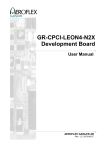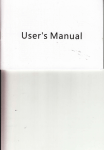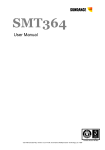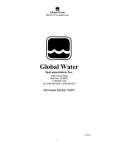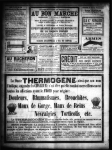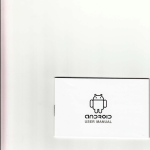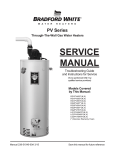Download February 20, 2006 Dr. Andrew Rawicz, Mr. Steve Whitmore & Mr
Transcript
School of Engineering Science Simon Fraser University Burnaby BC V5A 1S6 [email protected] February 20, 2006 Dr. Andrew Rawicz, Mr. Steve Whitmore & Mr. Brad Oldham School of Engineering Science Simon Fraser University Burnaby BC V5A 1S6 Dear Dr. Rawicz, Mr. Whitmore, and Mr. Oldham Please find the attached document, Functional Specification for a Mileage Recorder for Small Business Owner/Operators. The document outlines the functional requirements for our ENSC440/305 project. The functional specification document describes the functionality that our final product should offer. These specifications have been determined upon discussing our product with potential end-users, ensuring that we will be developing a product which meets the needs of our potential market. We have also attempted to ensure that we meet guidelines provided by the Canada Revenue Agency because the intended use of the device is to record mileage and help small business owners determine an appropriate income tax deduction based on the percent of vehicle use for business purposes in comparison to total vehicle use. OnBoard Travel Technologies is comprised of four highly motivated and skilled engineers: Bergen Fletcher, Ali Abdul-Hussein, Lena Lee, and Patrick Perrella. Please forward any questions or concerns to [email protected]. Best Regards, Bergen Fletcher Chief Executive Officer OnBoard Travel Technologies Enclosure: Functional Specification for a Mileage Recorder for Small Business Owner/Operators Copyright © 2006, OnBoard Travel Technologies School of Engineering Science Simon Fraser University Burnaby BC V5A 1S6 [email protected] Functional Specification for a Mileage Recorder for Small Business Owner/Operators Project Team: Contact: Submitted to: Issued Date: Revision Copyright © 2006, OnBoard Travel Technologies Bergen Fletcher Ali Abdul-Hussein Lena Lee Patrick Perrella Patrick Perrella [email protected] Dr. Andrew Rawicz, ENSC 440 Steve Whitmore, ENSC 305 Brad Oldham, ENSC 305/440 School of Engineering Science Simon Fraser University February 20, 2005 1.0 ii Functional Specifications for Mileage Recorder for Small Business Owner/Operators Executive Summary Many business owners track their vehicle business usage versus total use for income tax deduction purposes using methods such as estimation and logbooks, but often they find those methods inconvenient and inaccurate. OnBoard Travel Technologies (OBTT) aims at presenting a novel solution that is convenient, accurate, and cost-effective. OBTT plans to unveil an operational prototype of our solution early in April 2006. OBTT’s Plug n’Go system consists of two main subsystems; the Mileage Recorder Device (MRD) which is to be connected to the vehicle during all trips, and a PC application, which is used to display trip records and configure the MRD. The development of Plug n’Go will take place in two main phases; the first phase will primary deal with the functional specifications of both subsystems as well as the implementation of the MRD hardware. The second phase will include the full integration of the MRD firmware modules, and system testing and optimization. Upon the completion of the development phases, the system should support the following functionalities: • • • • • The user may easily display recorded trip data on a PC software application. The user may access and modify MRD configuration parameters. The MRD can be quickly connected to the vehicle and removed anytime the vehicle is stopped so that the MRD can be taken to a PC to which it can be connected facilitating communication with a PC software application. The device would provide the ability to accommodate multiple vehicles and multiple drivers. The user may easily read, interpret, and respond to the MRD user interface when the MRD is connected to the vehicle. This document contains full details of the proposed functional specifications for the MRD hardware and firmware, the PC software as well as reliability, regulatory, and documentation requirements. OBTT is scheduled to produce operational prototypes of the MRD, the PC software and required interfaces to be ready for demonstration by the first week of April 2006. Copyright © 2006, OnBoard Travel Technologies iii Functional Specifications for Mileage Recorder for Small Business Owner/Operators Table of Contents EXECUTIVE SUMMARY ............................................................................................... II TABLE OF CONTENTS ...............................................................................................III LIST OF FIGURES AND TABLES ............................................................................. IV ACRONYMS ................................................................................................................... IV 1 INTRODUCTION..................................................................................................... 4 1.1 1.2 2 INTENDED AUDIENCE .......................................................................................... 4 DOCUMENT CONVENTIONS ................................................................................. 4 GENERAL SYSTEM REQUIREMENTS ............................................................. 5 2.1 2.2 3 SYSTEM OVERVIEW ............................................................................................. 5 GENERAL SYSTEM REQUIREMENTS ...................................................................... 5 MILEAGE RECORDER DEVICE REQUIREMENTS....................................... 6 3.1 3.2 HARDWARE .......................................................................................................... 6 FIRMWARE ........................................................................................................... 6 4 PC SOFTWARE REQUIREMENTS ..................................................................... 7 5 RELIABILITY AND SERVICEABILITY REQUIREMENTS........................... 8 6 REGULATORY REQUIREMENTS ...................................................................... 9 7 USER DOCUMENTS REQUIREMENTS ........................................................... 10 8 TESTING REQUIREMENTS............................................................................... 10 8.1 8.2 8.3 9 SOFTWARE TESTING........................................................................................... 10 HARDWARE TESTING ......................................................................................... 11 USER TESTING ................................................................................................... 11 VEHICLE DEVICE INSTALLATION TRAINING REQUIREMENTS......... 11 10 CONCLUSION ................................................................................................... 12 11 REFERENCES.................................................................................................... 13 Copyright © 2006, OnBoard Travel Technologies iv Functional Specifications for Mileage Recorder for Small Business Owner/Operators List of Figures and Tables Figure 1: System Overview ................................................................................................ 5 Acronyms CRA CSV MRD MRDUI OBTT PC VAC VSS Canada Revenue Agency Comma Separated Value Mileage Recorder Device Mileage Recorder Device User Interface OnBoard Travel Technology Personal Computer Volts, Alternating Current Vehicle Speed Sensor Copyright © 2006, OnBoard Travel Technologies 4 Functional Specifications for Mileage Recorder for Small Business Owner/Operators 1 Introduction OnBoard Travel Technologies’ Plug n’Go is a system which consists of a compact device which can be connected to a vehicle’s odometer to record the vehicle’s mileage. The system also includes Windows® software which is capable of configuring the recorder device and downloading trip records from the device via a standard PC to peripheral interface, such as USB. The Plug n’Go system is intended to aid small business owner/operators in keeping adequate vehicle usage records such that they can claim income tax deductions correctly; ensuring proper records are kept in the event of an audit. 1.1 Intended Audience The intended purpose of this document is to help ensure design engineers meet the requirements of the end-user while designing the product. The document will also serve as a checklist for the company executives and project managers as they ensure that the development of the product is running inline with the intended function of the product. The requirements of the device can also serve as marketing points and portions could be feature in future promotional material for the product. 1.2 Document Conventions Throughout the document the following convention will be used to signify a functional requirement: {REQ#} Example Requirement Text. {LEVn} Where n is either: (1) Indicating a requirement that will be met in the prototype completed in April 2006. (2) Indicating a requirement that should be met upon going into full production. Copyright © 2006, OnBoard Travel Technologies 5 Functional Specifications for Mileage Recorder for Small Business Owner/Operators 2 General System Requirements 2.1 System Overview The system will consist of a Mileage Recorder Device (MRD) which can be connected to a vehicle to acquire trip information and store such information in memory. The MRD can be easily removed from the vehicle and connected to a PC via a standard interface allowing the MRD to exchange data with the PC. Most notably, this data transaction will consist of downloading trip records to the PC. The system will include PC software which facilitates this data transaction and organizes the downloaded trip information into a user desirable format. Figure 1: System Overview 2.2 General System Requirements {REQ1} {REQ2} {REQ3} {REQ4} {REQ5} {REQ6} System must record trip date, destination, and distance travelled as per Canada Revenue Agency (CRA)[1] recommendation for tax deduction purposes. {LEV1} Additionally, as indicated by possible end-users, the device should be able to record the trip time, trip type (business/pleasure). {LEV1} The device should accommodate and record usage in more than one vehicle (up to four), and by more than one user/driver (up to four). {LEV1} Additionally, as recommended by possible end-users, allowing the user to input their fuel purchases would be a favourable feature (including per litre fuel cost and litres purchased). {LEV1} The system must connect to a vehicle’s odometer system and be compatible with most vehicles built after 1996. {LEV1} The final production device should have a market price under $150, not including installation/labour. {LEV2} Copyright © 2006, OnBoard Travel Technologies 6 Functional Specifications for Mileage Recorder for Small Business Owner/Operators 3 Mileage Recorder Device Requirements 3.1 Hardware {REQ7} {REQ8} {REQ9} {REQ10} {REQ11} {REQ12} {REQ13} {REQ14} {REQ15} {REQ16} {REQ17} The MRD must be easily connected and disconnected from the vehicle but this may be achieved by a secondary piece of hardware (i.e. a “dock”) which is always connected to the vehicle and provides a “quick connect” interface for the main device. {LEV2} The MRD must have a real time clock (RTC) capable of keeping track of date and time even when the device is un-powered (a small battery may be used to run the clock). {LEV1} The MRD must acquire the odometer signal and ignition ON/OFF signal from the vehicle’s sensors, without over-loading the sensors. {LEV1} The MRD must have an interface compatible with PC computers to be used for device configuration and recorded data uploading purposes. {LEV1} The MRD must be as compact as possible (user should be able to hold the device in one hand). {LEV1} The MRD must have a user-friendly interface including an electronic display (i.e. LCD) and input hardware (i.e. pushbuttons) which allows the user to input required data (i.e. select destination, trip type, etc.). {LEV1} The MRD must contain enough memory to store at least 3 months worth of trip records, in the range of 900-1000 trips assuming 10 trips per day. {LEV1} The MRD should be visually appealing, and designed to be ergonomically correct. {LEV2} The MRD must include a standard PC compatible data transfer interface. {LEV1} The MRD must be powered from a low voltage (i.e. 5V DC), and should draw no more than 500 mA. {LEV1} The MRD must be able to acquire power from the vehicle’s battery and also from a PC via a standard communication interface. The MRD must be designed to ensure that both power sources cannot be connected at the same time, or that they do not load one another if both are connected. {LEV1} 3.2 Firmware {REQ18} The firmware shall include a user interface (MRDUI) designed according to good design principles. The MRDUI must be intuitive such that the average Copyright © 2006, OnBoard Travel Technologies 7 Functional Specifications for Mileage Recorder for Small Business Owner/Operators {REQ19} {REQ20} {REQ21} {REQ22} {REQ23} {REQ24} {REQ25} {REQ26} {REQ27} user can determine how to use the system without having to consult a user manual or obtain formal user training. {LEV1} The firmware must commit trip information to non-volatile memory when the ignition is shut off. {LEV1} When the ignition has been shut off and data committed to memory, the firmware shall place the MRD into a low power sleep mode as to not drain the vehicle’s battery. {LEV2} The firmware must awake the MRD from the low-power sleep mode upon receiving input from the user interface or when the vehicle ignition is toggled on. {LEV2} Upon the vehicle ignition toggling on, the MRDUI shall acquire trip type, trip destination, user name, and vehicle name. {LEV1} When acquiring user-specified trip information, the MRDUI should use information from last trip as the default information for the next trip. {LEV2} The MRDUI should provide the user the ability to cancel in-progress trips. {LEV1} The firmware should acquire from the RTC and record to memory the date and time of both the beginning and end of the trip. {LEV1} The MRDUI should allow user to enter in a gas purchase, including amount of fuel purchased (i.e. litres) and price per unit of fuel (i.e. ¢/litre). {LEV1} The MRDUI should provide the user an indication of the status of the memory of the device in terms of how many additional trips can be recorded. {LEV1} 4 PC Software Requirements {REQ28} The PC software must be compatible with Microsoft® Windows XP, and Windows 2000. {LEV1} {REQ29} Additional software will be provided for other platforms such as Apple OSX. {LEV2} {REQ30} The PC software must be able to communicate to the MRD via an industry standard interface. {LEV1} {REQ31} Provide a standard Windows GUI. The GUI should be designed such that its usage is intuitive to the average user and follow the design standards of a typical Windows software program. {LEV1} {REQ32} The GUI should allow the user to create an onscreen spreadsheet presenting all trip and gas purchase information downloaded from the device. The formatting of this spreadsheet should be flexible as to allow the user to specify how the data is organized and sorted. This formatting should also allow the user to view only records containing certain information (i.e. only gas purchase records, or only trips to a certain destination). {LEV1} Copyright © 2006, OnBoard Travel Technologies 8 Functional Specifications for Mileage Recorder for Small Business Owner/Operators {REQ33} The GUI should allow user to print the onscreen spreadsheet to an available Windows printer. {LEV1} {REQ34} The GUI should allow the user to calculate vehicle usage and fuel purchase statistics. (i.e. mileage totals, business to pleasure trip ratios, total fuel purchases, etc.) {LEV1} {REQ35} The GUI should allow the user to view vehicle usage and fuel purchase information graphically (e.g. a pie-chart showing percentage personal vs. business usage, or a bar graph showing total distance traveled to different destinations) {LEV2} {REQ36} The GUI must allow the user to able to save recorded data in a format recognized by Microsoft Excel (i.e. Comma Separated Value Format (CSV)) {LEV1} {REQ37} The GUI should display all information using metric units. {LEV1} {REQ38} The GUI should provide the user the option to display all information using American units (miles, gallons). {LEV2} {REQ39} The software should be able to determine when two recorded trips taken within a short period of time from one another to the same destination; this may indicate two legs of a larger trip. {LEV2} {REQ40} The GUI should allow user to enter miscellaneous vehicle costs, including insurance, repairs/maintenance, and capital costs. {LEV1} {REQ41} The GUI should allow the user to calculate their eligible income tax deductible vehicle expenditure, based on percentage business use to total use multiplied by total vehicle costs. {LEV1} {REQ42} The GUI must allow user to edit the destination, vehicle, and driver lists to be used on the MRD (These lists will have a finite length). The GUI should also allow user to configure the MRD’s time/date and Vehicle Speed Sensor (VSS) calibration value. The GUI software shall allow the user to upload these lists and configuration information to the MRD. {LEV1} 5 Reliability and Serviceability Requirements {REQ43} The MRD should withstand 100 drop tests from a height of 1 m onto concrete. The drop testing procedure will consist of dropping the MRD with various orientations such that it will hit the ground with different corners and faces of its casing. {LEV2} {REQ44} The MRD firmware shall be updateable through the PC interface to ensure firmware can be updated by the end user should bugs be found in the firmware after product release. {LEV2} {REQ45} The PC software shall be user updateable via downloads available online: updates will be provided to fix bugs and other program errors. {LEV2} Copyright © 2006, OnBoard Travel Technologies 9 Functional Specifications for Mileage Recorder for Small Business Owner/Operators {REQ46} The MRD will be enclosed in a plastic enclosure held together with security screws to reduce the chances of the user tampering with the internal electronics of the device. {LEV2} {REQ47} OBTT will provide a one-year warranty on the MRD hardware. The warranty will be honoured for devices damaged during “normal use”. {LEV2} 6 Regulatory Requirements Our sources indicate that no mandatory regulatory certifications exist which would likely apply to a design meeting our functional requirements for our product if it was to be marketed. A design meeting our requirements does not require a large amount of power and thus would not necessarily need to connect directly to a standard 115 VAC outlet. There seems to be no electrical safety standards for devices that do not plug directly into an electrical outlet. There are also no additional safety requirements for a device powered from a car or from a computer, a fact that has been confirmed by The BC Safety Authority. The BC Safety Authority is the organization which makes the ultimate decision on electrical safety matters in British Columbia. Furthermore, our design team inquired with the Canada Revenue Agency (CRA) about any guidelines they may have with regards to products used for income tax records keeping purposes. The representative we spoke with from the CRA was receptive to the concept, but confirmed that the CRA does not have any applicable standards or policies restricting a device like the Plug n’Go. Specifically, CRA does not have any requirements as to how a log of vehicle usage is kept, as long as it is done so in a reasonably detailed manner, meeting the guidelines laid out in “Motor Vehicle Expenses Claimed by Self-Employed Individuals”[1]. In addition, there is no current CRA process for certifying devices such as ours, but they have a certification process in place for income tax software. OBBT could attempt to have CRA certification purely for marketing purposes, since having the CRA backing our product would likely be a huge selling point within Canada. For the CRA certifying products such as the Plug n’Go is somewhat new territory for the agency that they would have to address in the event that OBTT chooses this as a route to market the Plug n’Go. Copyright © 2006, OnBoard Travel Technologies 10 Functional Specifications for Mileage Recorder for Small Business Owner/Operators 7 User Documents Requirements Users will not require training to use the Plug n’Go product. {REQ18} and {REQ31} indicates that MDRUI and Windows GUI will be intuitive and user friendly. Users who prefer dive straight into using the product will be able to do so. However, user documents will be available for users who prefer to learn from instructions and tutorials. Additional online help, including the paper documents duplicated in digital form, would also be available to users. {REQ48} The GUI should provide a standard Windows online help interface, with information describing how to use the complete Plug n’Go system – the MRDUI and the Windows GUI software. {LEV2} {REQ49} Step by step instructions should provide users with description of how to attach the device to their cars and PCs. The instructions will be printed on paper which comes with the package. Digital copies should be available online if users wish to obtain multiple copies. {LEV2} {REQ50} An online tutorial should provide users how to use various features of Windows GUI software. The tutorial should be separate into different skill levels – beginner, novice, and expert. {LEV2} 8 Testing Requirements To ensure a quality product and user satisfaction, testing will be done throughout the development and manufacturing processes. 8.1 Software Testing Software testing separately tests the MRDUI and Windows GUI ensuring they work on their intended platforms. {REQ51} Unit testing should be conducted for each software module created for both MRDUI and Windows GUI. {LEV1} {REQ52} Integration testing should be conducted each time a module has met {REQ54} and ready to add to master code. {LEV1} {REQ53} System testing should be conducted after all modules have been integrated and met {REQ55}. Core features and functionalities specified by previous requirements will be tested. Copyright © 2006, OnBoard Travel Technologies 11 Functional Specifications for Mileage Recorder for Small Business Owner/Operators 8.2 Hardware Testing Hardware testing will be conducted after all software testing have been completed. This is a mass system integration testing. {REQ54} MRD-vehicle interface should be tested to ensure that the MRD correctly decodes Vehicle Speed Sensor (VSS) signals and recognizes ignition toggling. {LEV2} {REQ55} MRD-PC interface should be tested to ensure reliable data communication with PCs. {LEV1} {REQ56} The MRD hardware should undergo testing which verifies that it meets the complete range of functional requirements specified in this document. Most notably, this should include verifying that the MRD can receive and interpret the VSS signal from a range different vehicles, can correctly record trip data, and can interface reliably with a number of different PCs. {LEV2} 8.3 User Testing To ensure users can use the Plug n’Go system without needing to consult a user manual or undergoing training, user testing will be done on the device interface. User testing will require conducting of usability tests with randomly picked users with a range of technical expertise. {REQ57} User testing should be conducted on MRDUI. {LEV2} {REQ58} User testing should be conducted on Windows GUI. {LEV2} {REQ59} User testing should be conducted on complete Plug n’Go product. This should include counting pulses from vehicles, recording trip data on device, uploading trip data, and managing trip data on PCs. {LEV2} 9 Vehicle Device Installation Training Requirements The MRD will likely need to be installed by a personal with basic knowledge of vehicle electrical systems. The device requires connection to the vehicle’s power, the ignition signal, and the Vehicle Speed Sensor (VSS). These requirements are much like those of car audio and alarm systems which are often installed in the end-user’s vehicle at the point of purchase by qualified technician. The Plug n’Go hardware will be marketed to be installed in the same way. {REQ60} Documentation shall be provided describing the installation process. {LEV2} Copyright © 2006, OnBoard Travel Technologies 12 Functional Specifications for Mileage Recorder for Small Business Owner/Operators {REQ61} Training courses will be provided to official retailers of the Plug n’Go product. Technicians working for theses official retailers will achieve “Qualified OnBoard Travel Technology Installer” status upon completion of the training course. {LEV2} {REQ62} Qualified OnBoard Travel Technology Installers will be provided access to an online database of vehicle wiring diagrams indicating locations of required connections for installing the Plug n’Go product. {LEV2} 10 Conclusion As the development phases of the Plug n’Go pro progress, we will make sure the device is fully capable of supporting all the enlisted functional requirements. OBTT’s design and test engineers will ensure that the device can be easily installed, connected and operated in all conditions. The enlisted specifications will provide a solid reference to our team in both the development as well as the testing phases of the process. Having defined the specifications, we are certain that we can satisfy our proposed prototype requirements by the fist week of April. Copyright © 2006, OnBoard Travel Technologies 13 Functional Specifications for Mileage Recorder for Small Business Owner/Operators 11 References [1] Canada Revenue Agency, Motor Vehicle Expenses Claimed by Self-Employed Individuals, December 16, 1996, http://www.cra-arc.gc.ca/E/pub/tp/it521r/it521re.html, Viewed: Jan 16, 2006 Copyright © 2006, OnBoard Travel Technologies















